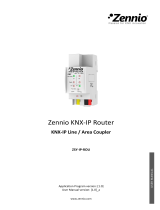Page is loading ...

Smart home and building solutions. Global. Secure. Connected.
28 | Checklist | Checklist for increased security and privacy in KNX installations
CHECKLIST
Increased security and privacy
in KNX installations
1. Were the following measures taken into
account during installation?
Are devices and applications fixed mounted? Is it ensured that devices are properly
protected against dismounting (e. g. use of anti-theft protection measures)?
Is it ensured that unauthorized persons have limited access to distribution boards
with mounted KNX installations (e. g. always locked or located in locked rooms)?
Is it dicult to access devices in external areas? (e. g. mounted at a sucient height)?
In case the KNX installation can be operated from areas in buildings that are public
and not surveilled, did you contemplate the use of binary inputs (mounted in distribution
boards) or push button interfaces?
Are KNX Touch panels password protected (user, group or guest mode)?
2. Is Twisted Pair used as communication medium?
Is the cable anywhere in- or outside the home or the building protected
against unauthorized access?
In case the twisted pair cable is used in areas requiring extra protection measures,
have you taken the measures as given in item 6?
3. Is Powerline used as communication medium?
Have band stop filters been installed?
If Powerline is also used outside the building, have you taken the same measures
for the media coupler as given in item 6?

KNX.ORG
Checklist for increased security and privacy in KNX installations | Checklist | 29
4. Is IP used as communication medium?
Have the network settings been documented and handed over to the home owner
or the LAN administrator?
Have switches and routers been set in such a way that only known MAC addresses
are able to access the communication medium?
Is a separate LAN or WLAN network with own hardware used for KNX communication?
Is access to the (KNX) IP networks limited to authorized persons via appropriate user
names and strong passwords?
For KNX IP Multicast communication another IP address as the default address should be
used (normally 224.0.23.12). Was this IP multicast address changed?
Was the default SSID of the wireless access point changed? Was the periodic transmission
of the SSID after installation deactivated?
Have ports of routers for KNX been closed towards the internet and was the default gate-
way of the used KNXnet / IP router set to 0? Was the (W)LAN installation protected by an
appropriate firewall?
If internet access to a KNX installation is needed, check the possibility to implement:
1. Establishing a VPN connection to the Internet Router
2. Use of manufacturer specific KNX Object Servers
5. Is Radio Frequency used as communication medium?
Have you taken the same measures for the media coupler as given in item 6?
Does each RF domain have a dierent domain address?
6. Have you used couplers in the installation?
Were individual addresses of devices assigned according to their place in the topology?
Do you prevent via the setting of appropriate parameters in the couplers
that incorrect source addresses are not forwarded outside the line?
Do you block Point-to-Point and Broadcast communication across couplers?
Have the filter tables been loaded correctly and have settings been made
in such a way that filter tables are taken into account by the couplers?
Have you considered the measures as given under item 7 for the couplers?
8. Do you use KNX Secure2 devices?
For group communication that needs to be secured, use the foreseen authentication
and encryption mechanisms of the device.
7. Have devices been locked against re-configuration?
If not, enter a BCU key1 in the ETS Project.

Smart home and building solutions. Global. Secure. Connected.
30 | Checklist | Checklist for increased security and privacy in KNX installations
1 Not all devices can be protected against re-configuration – contact the relevant manufacturer
2 Available from ETS 5.5 onwards
3 Is not supported in all devices
9. Do you suspect unauthorized access to the bus?
Record telegram trac and analyse it. In the case of KNX Secure devices, read the Failure
Logs. Document the time and observed eects (what happens, what does not happen, why
and when)? Disable the internet connection of the KNX system and check, whether the ef-
fects disappear or not. Contact the hotline of the manufacturer: are the eects or security
problems known at the manufacturer, are updates available?
Read the PID_Device_Control3 from devices and check whether devices
are sending using the same Individual Address.
Read the PID_Download_Counter3 from devices and check whether the device
was downloaded again after your configuration.
10. Have devices been locked against re-configuration?
When KNX is coupled to security installations, was this realized in any of the following
ways?
1. Via KNX devices or gateways certified by national loss insurers?
2. Via potential free contacts (binary inputs, push button interfaces, ...)?
3. Via appropriate interfaces (RS232, ...) or gateways: was it ensured
that KNX communication is unable to trigger security relevant functions
in the security part of the installation?
11. General Security Measures
Is ETS up to date?
1. Is the PC, on which the ETS is installed, secure (up to date virus scan, newest operat-
ing system update)? It is recommended, to use a dedicated device for KNX design and
commissioning.
2. During the installation, it shall be avoided to hook other untrusted data storage devices
up to the PC (USB, external hard drive, …).
3. ETS Plug-ins and Apps shall preferably be installed prior to the installation
4. Backup the project file after the installation (ideally on a secured USB stick, which is
stored safely) and delete the project from the PC.
Is the firmware of the used devices up to date?
12. Further Privacy measures (GDPR)
Installer and customer shall sign a privacy declaration.
In order to fulfil the GDPR regulations, the installer shall hand over a copy of the ETS project
file to the customer.
/
